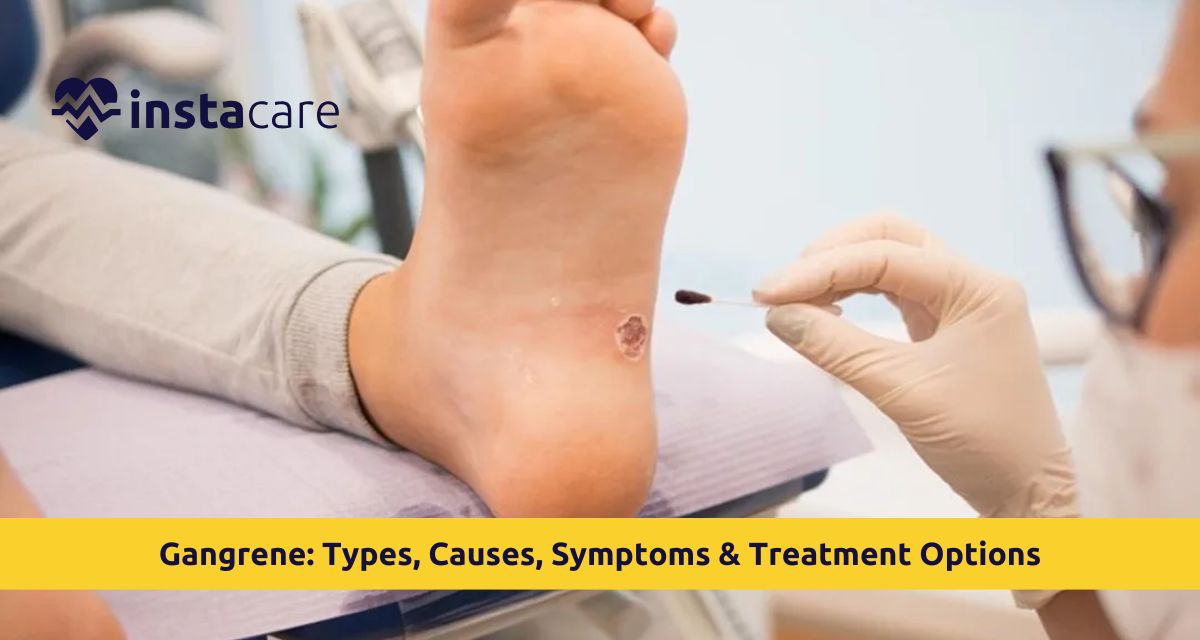Gangrene is a life-threatening and severe illness characterized by death of body tissue. Gangrene most commonly results from a deficiency of blood supply to an extremity due to trauma, infection, or disease. Gangrene can cause death or amputation if left untreated. For this reason, early diagnosis and treatment should be sought.
Regardless of whether it is diabetic gangrene, circulatory gangrene, or traumatic gangrene, the doctors and patients should know gangrene and what gangrene is. Through this guidebook, we will walk you through its causes, symptoms, treatment, prevention, and types.
What Is Gangrene?
Gangrene is tissue death brought about by the absence of blood circulation or infection. The tissue will start to rot and die since it does not receive oxygen and nutrients. It most commonly happens in the extremities such as the fingers, toes, arms, and legs but sometimes internally as well.
It may onset abruptly or slowly based on cause. Patients with
diabetes, vascular disorders, or immunocompromised states are at risk of gangrene and should visit the doctor for follow-up and maintenance periodically.
Types of Gangrene
Gangrene is of various types, and there are characteristics as well as causative agents behind every type. Detection of the type is essential to initiate the treatment.
Dry Gangrene
Dry gangrene develops progressively due to reduced blood supply over a period of time. Dry gangrene develops most frequently in patients with circulatory disease such as diabetes or atherosclerosis. Dry and puckered skin with brown-black pigmentation. Dry gangrene is infrequently caused by infection as in other forms of gangrene.
Wet Gangrene
Wet gangrene is due to bacterial infection and is contagious. Blistering, swelling, and bad odor are its consequences. It is always accompanied by pus. It must be treated immediately as the infection may be transmitted to the blood and sepsis will ensue.
Gas Gangrene
Gas gangrene is an acute, fulminant infection of Clostridium bacteria. They release toxins that are tissue destroyers along with the production of gas within the skin. It also includes pain that is extremely severe, swelling, and crepitus on examination. Emergency surgery should be performed.
Internal Gangrene
Internal gangrene develops in internal organs like intestines, gallbladder, or appendix and primarily through hernias, obstruction, or infection. It is more difficult to diagnose but equally as dangerous and must be treated equally with equal urgency by a physician.
Fournier's Gangrene
This is a rare and severe form of gangrene that affects the genitalia and perineum. It is more prevalent in men and immunocompromised/diabetes. Fournier's gangrene is highly contagious and treated most commonly with radical surgery and antibiotics.
Causes of Gangrene
- Gangrene is triggered by the occlusion of blood supply to an extremity. Necrosis of tissue is caused by the lack of oxygen-carrying blood. It can be triggered by a number of underlying conditions such as trauma, infection, or chronic illness.
- Impaired circulation is most frequent, in diabetic or peripheral artery disease patients. Unrecognized trauma with resulting open wound also may provide opportunity for bacterial infection resulting in wet or gas gangrene. Burns, frostbite, and surgical catastrophe are other known stimuli.
- Some are more prone than others. Smokers, patients with cholesterol or autoimmune illness are more prone to impaired blood supply and thus prone to dead tissue.
View More: Everything You Need to Know About Radiation Poisoning
Symptoms of Gangrene
- The presentation and symptoms of gangrene are based on its type and site. Gangrene in general includes the skin, muscle, and visceral organs and its onset is acute or delayed.
- Early warning signs are pain in the area, with numbness if nerves start to die. The skin also may turn color, pale, blue, purple, or eventually black. Swelling and foul-smelling discharge also are to be anticipated in infected forms. The blisters or sores also may be seen.
- In gas gangrene, on applying pressure to the skin, a crackling noise is heard due to gas bubbles beneath the skin. Internal gangrene is suggestive of fever, pain, and nausea. When infection is progressing, the patient becomes confused, with a fast pulse, and low blood pressure—features of sepsis most typically fatal.
Diagnosis of Gangrene
- Diagnosis of gangrene will also typically begin with a physical examination. Physicians will examine the infected site and note the color of the site, temperature, and signs of infection. A blood test may be prescribed to diagnose the infection or toxin.
- Imaging procedures such as X-ray, MRI, or CT scan are useful to see the extent of gangrene. They are particularly useful in gas gangrene, where the tissue within is discovered to be degenerating at a very rapid pace. Biopsy of tissue or culture of the fluid is usually taken to determine the causative bacteria, and this will then guide the choice of antibiotic.
Treatment Options for Gangrene
Treatment involves debridement of necrotic tissue, preventing infection, and re-establishing a blood supply. Treatment will be most effective the sooner that the treatment is started.
- Surgeon removal of the dead flesh is usually the most common type of treatment. In the most serious cases, amputation of the affected arm or leg must be performed in a last hope attempt to prevent the infection spreading further. Antibiotics will need to be prescribed, particularly where there is wet or gas gangrene. These usually are administered intravenously in hospital.
- Hyperbaric oxygen therapy can be applied. This involves the patient being placed in a pressurized chamber in a manner that he is subjected to pure oxygen. This increases the immunity of the body against infection as well as oxygen-free tissue healing.
- In clogged arteries, patients, vascular surgery such as angioplasty or bypass surgery can repair proper circulation, which saves tissue.
Prevention of Gangrene
Although gangrene can be sudden, prevention is achievable with good care and information. You need proper lifestyle and regular checkup when you have diabetes or compromised circulation.
To lower your chances of developing gangrene:
- Regulate and check blood sugar if diabetic
- Smoking cessation to improve circulation
- Care and dress wounds properly
- Inspect hands and feet daily for redness or injury
- Consume a good diet to ensure vascular health
- Layering dressings in cold weather to prevent frostbite
- Early treatment or infection reduces risk of gangrene by a very high percentage.
Recovery and Follow-up
Gangrene recovery will depend on the diagnosis and treatment rate. Post-operative follow-up will include rest to recover from surgery and regain function and strength if amputation was done.
Most important key recovery points are:
- Completely finish courses of antibiotics
- Follow-up visits
- Successful chronic disease control
- Adding physical therapy to the choices of use of mobility aid
- Adding counseling, if necessary
Emotional recovery as well, particularly in those who have had extensive surgery or amputation.
Conclusion
Nursing evaluation of gangrene demands urgent medical intervention because it creates dangerous medical crises. Early detection alongside appropriate treatment depends on realizing gangrene characteristics together with its origins and symptom patterns. Different effective medical treatment options exist today to handle and treat gangrene after standard advancements in healthcare. Complete knowledge about the situation together with immediate medical care help produce better results and protect overall health.
Please book an appointment with the
best General Surgeon in Lahore, Karachi, Islamabad, and all major cities of Pakistan through
InstaCare, or call our helpline at 03171777509 to find the verified doctor for your disease.

